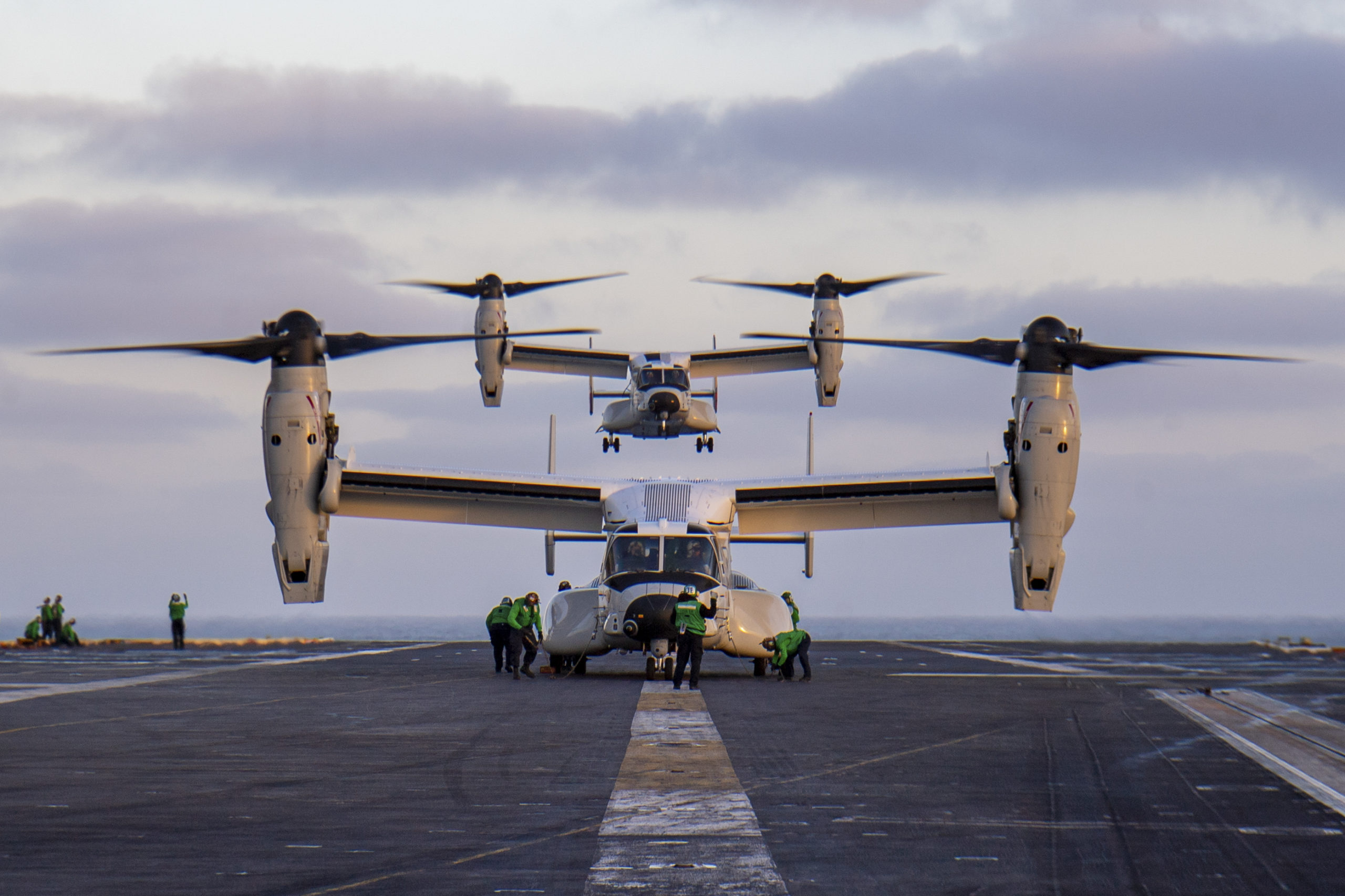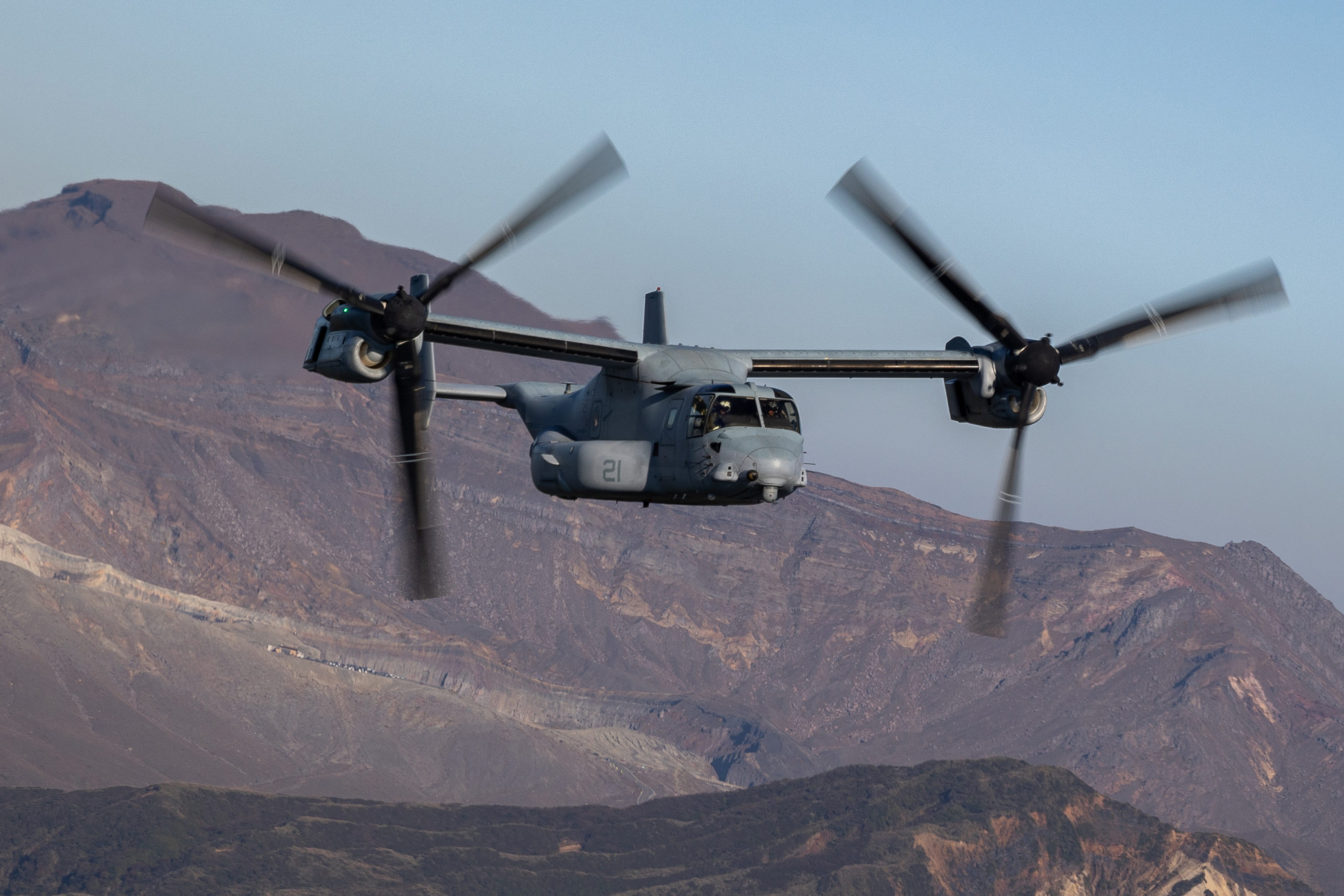The Timeline for the Tiltrotor Enterprise: A Platform Perspective
There are various ways one can conceptualize the timeline for the emergence and evolution of the tiltrotor enterprise. One way to do so is by the platforms which have been developed and operated by the various services since the introduction of tiltrotor capability.
By IOCs, the four platforms associated with this enterprise go from the MV-22B to the CV-22 to the CMV-22B to the FLRAA or Future Long-Range Assault Aircraft.
MV-22B: IOC 2007
This is the backbone of the enterprise. The pioneer platform and with the USMC driving its development and concepts of operations, it provided the breakthrough for the use of this innovative technological capability.
This is how NAVAIR describes it:
The MV-22B Osprey is a tiltrotor V/STOL aircraft designed as the medium-lift replacement for the CH-46E Sea Knight assault support helicopter. The Osprey can operate as a helicopter or a turboprop aircraft and offers twice the speed, six times the range, and three times the payload of the CH-46E.
Initial Operational Capability (IOC) for the MV-22B was declared in June 2007. The Osprey had three successful combat deployments in Iraq from October 2007 to April 2009 with VMM-263, VMM-162 and VMM-266 respectively. VMM-263 embarked on the first MV-22 shipboard deployment with the Bataan Ready Group in May 2009 as part of the 22nd Marine Expeditionary Unit (MEU).
The CV-22B: IOC 2009
The CV-22 is the specialized variant of the Osprey designed to replace Air Force special forces operations.
This aircraft has always interested me in part because of my relationship with Dr. Zbigniew Brzezinski. He was my main professor at Columbia University when working on my PhD and then my boss at the Research institute of International Change at Columbia. When he went to Washington, I would follow and we stayed in contact afterword.
Of course, he was one of the key policy makers launching the unsuccessful attempt to rescue U.S. hostages in Tehran. Ironically, the Marines would develop a capability to do this type of mission with the SP-MAGTF.
I remember a meeting with Brzezinski where I described the SP-MAGTF and its function (which was shaped after the Benghazi situation) and which he felt if such capability was available when he was NSC advisor, the mission would have succeeded.

This is how NAVAIR describes the CV-22B:
The CV-22 is the Air Force Special Operations Command (AFSOC) variant of the U.S. Marine Corps MV-22 Osprey. The CV-22’s mission is to conduct long-range infiltration, exfiltration and resupply missions for special operations forces.
Like the MV-22 Osprey, the CV-22 is a tiltrotor aircraft that combines the vertical takeoff, hover, and vertical landing qualities of a helicopter with the long-range, fuel efficiency and speed characteristics of a turboprop aircraft. Those capabilities give this versatile, self-deployable aircraft the capability to conduct missions that would normally require both fixed-wing and rotary-wing aircraft.
The CV-22 is equipped with integrated threat countermeasures, terrain-following radar, forward-looking infrared sensor, and other advanced avionics systems that allow it to operate at low altitude in adverse weather conditions and medium- to high-threat environments.
The first two test aircraft were delivered to Edwards Air Force Base, Calif., in September 2000. The 58th Special Operations Wing at Kirtland AFB, NM began CV-22 aircrew training with the first two production aircraft in August 2006. The first operational CV-22 was delivered to Air Force Special Operations Command in January 2007. Initial operational capability was achieved in 2009.
The CMV-22B: IOC 2021
The CMV-22B was selected by the US Navy to replace the C-2A Greyhound for carrier support operations. But the versatility of the CMV-22B compared to the C-2A has opened a whole new way of fleet support.
This is how NAVAIR describes the CMV-22B:
The CMV-22B is the Navy’s long-range/medium-lift element of the intra-theater aerial logistics capability; it fulfills the Joint Force Maritime Component Commander (JFMCC) time-critical logistics air connector requirements by transporting personnel, mail and priority cargo from advance bases to the Seabase.
The CMV-22B Osprey is a variant of the MV-22B and is the replacement for the C-2A Greyhound for the Carrier Onboard Delivery (COD) mission. The Osprey is a tiltrotor V/STOL aircraft that can takeoff and land as a helicopter but transit as a turboprop aircraft.

It will provide the Navy with significant increases in capability and operational flexibility over the C-2A. CMV-22B operations can be either shore-based, “expeditionary”, or sea-based. The Osprey is a critical warfighting enabler, providing the time sensitive combat logistics needed to support combat operations.
As compared to the MV-22B, the Navy variant has extended operational range, a beyond line-of-sight HF radio, improved fuel dump capability, a public address system for passengers, and an improved lighting system for cargo loading. The CMV-22B will be capable of transporting up to 6,000 pounds of cargo/personnel to a 1,150 NM range.
The CMV-22B declared Initial Operational Capability (IOC) in 2021
The FLRAA or Future Long-Range Assault Aircraft: Downselect by US Army 2022
On December 5, 2022, the US Army downselected Bell’s new tiltrotor aircraft to provide for its new vertical lift capability.
The US Army labeled this as the FLRAA or Future Long-Range Assault Aircraft.
Army Chief of Staff Gen. James McConville in 2023 noted that the Bell aircraft cruise speed of more than 280 kt. and combat range of more than 500nm will be important for future operations in the Indo-Pacific.
What they’ve also done well is to get the aircraft more maneuverable at the destination. It’s good that you can go long range. It’s good that you can go fast. But then you have to be able to do the type of operations that we do—maneuver at the destination.
In a December 2023 article published by the US Army, the FLRAA was described this way: A tiltrotor aircraft, FLRAA will have the hybrid capabilities of planes and helicopters. When fielded, it will expand the depth of the battlefield by extending the reach of air assault missions and enable ground forces to converge through decentralized operations at extended distances.
FLRAA’s inherent reach and standoff capabilities will ensure mission success through tactical maneuver at operational and strategic distances while the aircraft’s speed and range will nearly double the Army’s patient evacuation capability during the “Golden Hour.”
The FLRAA is intended to eventually replace part of the U.S. Army’s UH-60 Black Hawk fleet, which has been in service for more than four decades.
The Army is inheriting the experience of the other services in their use and the evolution of the tiltrotor enterprise. Tiltrotors provide warfighting commanders and diplomatic missions across the globe operational lethality, flexibility, and surprise through the speed, range, payload, and survivability only a tiltrotor aircraft can provide. Tiltrotors allow commanders to respond rapidly to crisis at lower risk to friendly forces and lower diplomatic burdens, and can do so across great distances.
And in describing the purpose of the FLRAA, OSD underscored: “Units will utilize FLRAA’s increased speed, range, and maneuverability to assault enemy forces from areas of relative safety outside the range of enemy long-range fires. The FLRAA will be effective, decisive, and survivable in the lower tier of the air domain. It will integrate other programs within the FVL ecosystem.”
This is a new-build tiltrotor incorporating new technologies and capabilities designed to keep affordability and sustainability costs down and should prove attractive for allies as well. In fact, the US Army has a very proactive approach to involving allies in the program.
In an October 2022 article by Meredith Roaten, the Army’s focus on allied engagement in the program was underlined:
The Army’s team for next-generation helicopters and drones wants to bring more allies into the development process for its major programs, an official said Oct. 10. The United Kingdom and the Netherlands already have cooperation agreements with the Army, said Maj. Gen. Walter Rugen, director of the future vertical lift cross functional team. But the service is working to secure additional ways to bring its allies into the fold.
“More project agreements are probably in the works, but those are pre-decisional based on senior leadership at the department and the other countries finally agreeing,” Rugen said during the Association of the United States Army annual conference in Washington, D.C.
The United Kingdom and United States signed the program feasibility assessment earlier this year to ensure interoperability between the platforms developed out of future vertical lift — which includes the future long range assault aircraft and the future attack and reconnaissance aircraft — and the U.K.’s future systems. The Netherlands signed a similar agreement in July.
“Technological cooperation through arrangements like this improves our ability to collectively modernize and increase interoperability ensuring we can train and fight alongside our allies and partners more effectively and efficiently,” said Doug Bush, assistant secretary of the Army for acquisition, logistics and technology in a press release at the time.
The agreements this year lend additional freedom for the United States to provide partners insider information, Rugen noted.
“It gives us the authority to discuss at a higher classification level, our requirements and concepts, and so the info sharing is robust as well with our partners now,” he said.
Australia’s military has an embedded exchange officer in the future vertical lift cross functional team, which has led to “the Aussies working hand in glove with us,” he added.
Looking back and looking forward, one might note that the V-22 is a large amphibious connector often used for assaults and everything else.
The FLRAA is a purpose-built assault aircraft with the requisite reliability and affordability improvements to make a large fleet sustainable for the Army.
Yet even if the Army stops at its initial 573-aircraft buy, which it is unlikely to, their fleet will rapidly eclipse the size of the Marine, Navy, Air Force, and Japanese fleets. It is a new phase indeed for the tiltrotor enterprise.
In the next set of articles, I take another cut at a timeline for the tiltrotor exercises seen from the standpoint of phases of concepts of operations evolution.
Featured Photo:
A U.S. Marine Corps MV-22 Osprey tiltrotor aircraft with Marine Medium Tiltrotor Squadron (VMM) 262, Marine Aircraft Group 36, 1st Marine Aircraft Wing, conducts a bilateral formation flight alongside Japan Ground Self-Defense Force service members with Western Army Aviation Group during the field training exercise portion of Resolute Dragon 23 over Kumamoto, Japan, Oct. 18, 2023.
RD 23 is an annual bilateral exercise in Japan that strengthens the command, control, and multi-domain maneuver capabilities of Marines in III Marine Expeditionary Force and allied Japan Self-Defense Force personnel.
U.S. Marine Corps photo by Cpl. Kyle Chan.

